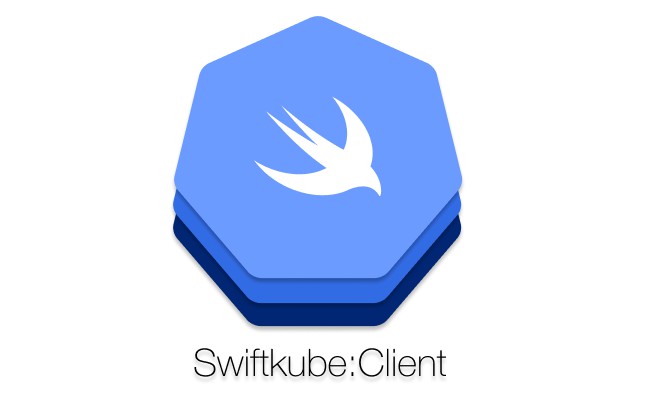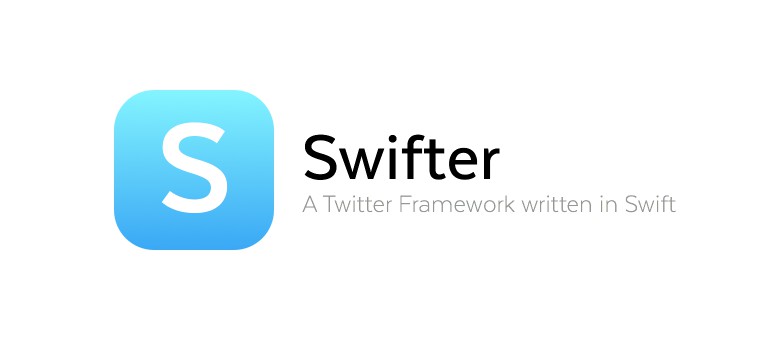Overview
Swift client for talking to a Kubernetes cluster via a fluent DSL based on SwiftNIO and the AysncHTTPClient.
- [x] Covers all Kubernetes API Groups in v1.20.9
- [x] Automatic configuration discovery
- [x] DSL style API
- [x] For all API Groups/Versions
- [x] Generic client support
- [x] Swift-Logging support
- [x] Loading resources from external sources
- [x] from files
- [x] from URLs
- [x] Read Options
- [x] List Options
- [x] Delete Options
- [ ] PATCH API
- [x]
/scaleAPI - [x]
/statusAPI - [x] Resource watch support
- [x] Follow pod logs support
- [x] Discovery API
- [ ] CRD support
- [ ] Controller/Informer support
- [x] Swift Metrics
- [ ] Complete documentation
- [ ] End-to-end tests
Compatibility Matrix
| <1.18.9 | 1.18.9 - 1.18.13 | 1.19.8 | 1.20.9 | |
|---|---|---|---|---|
| SwiftkubeClient 0.6.x | - | ✓ | - | - |
| SwiftkubeClient 0.7.x | - | - | ✓ | - |
| SwiftkubeClient 0.8.x | - | - | ✓ | - |
| SwiftkubeClient 0.9.x | - | - | ✓ | - |
| SwiftkubeClient 0.10.x | - | - | - | ✓ |
✓Exact match of API objects in both client and the Kubernetes version.-API objects mismatches either due to the removal of old API or the addition of new API. However, everything the client and Kubernetes have in common will work.
Examples
Concrete examples for using the Swiftkube tooling reside in the Swiftkube:Examples repository.
Usage
Creating a client
To create a client just import SwiftkubeClient and init an instance.
import SwiftkubeClient
let client = try KubernetesClient()
You should shut down the KubernetesClient instance, which in turn shuts down the underlying HTTPClient. Thus you shouldn't call client.syncShutdown() before all requests have finished. Alternatively, you can close the client asynchronously by providing a DispatchQueue for the completion callback.
// when finished close the client
try client.syncShutdown()
// or asynchronously
let queue: DispatchQueue = ...
client.shutdown(queue: queue) { (error: Error?) in
print(error)
}
Configuring the client
The client tries to resolve a kube config automatically from different sources in the following order:
- Kube config file in the user's
$HOME/.kube/configdirectory ServiceAccounttoken located at/var/run/secrets/kubernetes.io/serviceaccount/tokenand a mounted CA certificate, if it's running in Kubernetes.
Alternatively it can be configured manually, for example:
let caCert = try NIOSSLCertificate.fromPEMFile(caFile)
let authentication = KubernetesClientAuthentication.basicAuth(
username: "admin",
password: "admin"
)
let config = KubernetesClientConfig(
masterURL: "https://kubernetesmaster",
namespace: "default",
authentication: authentication,
trustRoots: NIOSSLTrustRoots.certificates(caCert),
insecureSkipTLSVerify: false
)
let client = KubernetesClient(config: config)
Client authentication
The following authentication schemes are supported:
- Basic Auth:
.basicAuth(username: String, password: String) - Bearer Token:
.bearer(token: String) - Client certificate:
.x509(clientCertificate: NIOSSLCertificate, clientKey: NIOSSLPrivateKey)
Client DSL
SwiftkubeClient defines convenience API to work with Kubernetes resources. Using this DSL is the same for all resources.
The examples use the blocking
wait()for brevity. API calls returnEventLoopFuturesthat can be composed and acted upon in an asynchronous way.
Currently only a subset of all API groups are accessible via the DSL. See Advanced usage for mor details.
List resources
let namespaces = try client.namespaces.list().wait()
let deployments = try client.appsV1.deployments.list(in: .allNamespaces).wait()
let roles = try client.rbacV1.roles.list(in: .namespace("ns")).wait()
You can filter the listed resources or limit the returned list size via the ListOptions:
let deployments = try client.appsV1.deployments.list(in: .allNamespaces, options: [
.labelSelector(.eq(["app": "nginx"])),
.labelSelector(.notIn(["env": ["dev", "staging"]])),
.labelSelector(.exists(["app", "env"])),
.fieldSelector(.eq(["status.phase": "Running"])),
.resourceVersion("9001"),
.limit(20),
.timeoutSeconds(10)
]).wait()
Get a resource
let namespace = try client.namespaces.get(name: "ns").wait()
let deployment = try client.appsV1.deployments.get(in: .namespace("ns"), name: "nginx").wait()
let roles = try client.rbacV1.roles.get(in: .namespace("ns"), name: "role").wait()
You can also provide the following ReadOptions:
let deployments = try client.appsV1.deployments.get(in: .allNamespaces, options: [
.pretty(true),
.exact(false),
.export(true)
]).wait()
Delete a resource
try.client.namespaces.delete(name: "ns").wait()
try client.appsV1.deployments.delete(in: .namespace("ns"), name: "nginx").wait()
try client.rbacV1.roles.delete(in: .namespace("ns"), name: "role").wait()
You can pass an instance of meta.v1.DeleteOptions to control the behaviour of the delete operation:
let deletOptions = meta.v1.DeleteOptions(
gracePeriodSeconds: 10,
propagationPolicy: "Foreground"
)
try client.pods.delete(in: .namespace("ns"), name: "nginx", options: deleteOptions).wait()
Create and update a resource
Resources can be created/updated directly or via the convenience builders defined in SwiftkubeModel
// Create a resouce instance and post it
let configMap = core.v1.ConfigMap(
metadata: meta.v1.Metadata(name: "test"),
data: ["foo": "bar"]
}
try cm = try client.configMaps.create(inNamespace: .default, configMap).wait()
// Or inline via a builder
let pod = try client.pods.create(inNamespace: .default) {
sk.pod {
$0.metadata = sk.metadata(name: "nginx")
$0.spec = sk.podSpec {
$0.containers = [
sk.container(name: "nginx") {
$0.image = "nginx"
}
]
}
}
}
.wait()
Watch a resource
You can watch for Kubernetes events about specific objects via the watch API.
Watching resources opens a persistent connection to the API server. The connection is represented by a SwiftkubeClientTask instance, that acts as an active "subscription" to the events stream.
The task can be cancelled any time to stop the watch.
let task: SwiftkubeClientTask = client.pods.watch(in: .allNamespaces) { (event, pod) in
print("\(event): \(pod)")
}
task.cancel()
You can also pass ListOptions to filter, i.e. select the required objects:
let options = [
.labelSelector(.eq(["app": "nginx"])),
.labelSelector(.exists(["env"]))
]
let task = client.pods.watch(in: .default, options: options) { (event, pod) in
print("\(event): \(pod)")
}
The client reconnects automatically and restarts the watch upon encountering non-recoverable errors. The reconnect behaviour can be controlled by passing an instance of RetryStrategy.
The default strategy is 10 retry attempts with a fixed 5 seconds delay between each attempt. The initial delay is one second. A jitter of 0.2 seconds is applied.
Passing RetryStrategy.never disables any reconnection attempts.
let strategy = RetryStrategy(
policy: .maxAttemtps(20),
backoff: .exponentiaBackoff(maxDelay: 60, multiplier: 2.0),
initialDelay = 5.0,
jitter = 0.2
)
let task = client.pods.watch(in: .default, retryStrategy: strategy) { (event, pod) in
print(pod)
}
To handle events you can pass a ResourceWatcherCallback.EventHandler closure, which is used as a callback for new events. The clients sends each event paired with the corresponding resource as a pair to this eventHandler.
If you require more control or stateful logic, then you can implement the ResourceWatcherDelegate protocol and pass it to the watch call:
class MyDelegate: ResourceWatcherDelegate {
typealias Resource = core.v1.Pod
func onEvent(event: EventType, resource: core.v1.Pod) {
// handle events
}
func onError(error: SwiftkubeClientError) {
// handle errors
}
}
let task = client.pods.watch(in: .default, delegate: MyDelegate())
Follow logs
The follow API resembles the watch. The difference being the closure/delegate signature:
:warning: The client does not reconnect on errors in follow mode.
let task = client.pods.follow(in: .default, name: "nginx", container: "app") { (line) in
print(line)
}
// The task can be cancelled later to stop following logs
task.cancel()
Discovery
The client provides a discovery interface for the API server, which can be used to retrieve the server version, the API groups and the API resources for a specific group version
let version: ResourceOrStatus<Info> = try client.discovery.serverVersion().wait()
let groups: ResourceOrStatus<meta.v1.APIGroupList> = try client.discovery.serverGroups().wait()
let resources: ResourceOrStatus<meta.v1.APIResourceList> = try client.discovery.serverResources(forGroupVersion: "apps/v1").wait()
Advanced usage
Loading from external sources
A resource can be loaded from a file or a URL:
// Load from URL, e.g. a file
let url = URL(fileURLWithPath: "/path/to/manifest.yaml")
let deployment = try apps.v1.Deployment.load(contentsOf: url)
API groups
To access API groups not defined as a DSL, e.g. rbac.v1beta1 a dedicated client can still be intantiated. A client can be either namespace scoped or cluster scoped:
try client.namespaceScoped(for: rbac.v1beta1.RoleBinding.self).list(in: .allNamespaces).wait()
try client.clusterScoped(for: rbac.v1beta1.ClusterRole.self).list().wait()
Type-erased usage
Often when working with Kubernetes the concrete type of the resource is not known or not relevant, e.g. when creating resources from a YAML manifest file. Other times the type or kind of the resource must be derived at runtime given its string representation.
Leveraging SwiftkubeModel's type-erased resource implementations AnyKubernetesAPIResource and its corresponding List-Type AnyKubernetesAPIResourceList it is possible to have a generic client instance, which must be initialized with a GroupVersionKind type:
guard let gvk = try? GroupVersionKind(for: "deployment") else {
// handle this
}
// Get by name
let resource: AnyKubernetesAPIResource = try client.for(gvk: gvk)
.get(in: .default , name: "nginx")
.wait()
// List all
let resources: AnyKubernetesAPIResourceList = try client.for(gvk: gvk)
.list(in: .allNamespaces)
.wait()
GroupVersionKind
A GroupVersionKind can be initialized from:
KubernetesAPIResourceinstanceKubernetesAPIResourcetype- Full API Group string
- Lowecassed singular resource kind
- Lowercased plural resource name
- lowecased short resource name
let deployment = ..
let gvk = GroupVersionKind(of: deployment)
let gvk = GroupVersionKind(of: apps.v1.Deployment.self)
let gvk = GroupVersionKind(rawValue: "apps/v1/Deployment")
let gvk = GroupVersionKind(for: "deployment")
let gvk = GroupVersionKind(for: "deployments")
let gvk = GroupVersionKind(for: "deploy")
Metrics
KubernetesClient uses SwiftMetrics to collect metric information about the requests count and latencies.
The following metrics are gathered:
sk_http_requests_total(counter): the total count of the requests made by the client.sk_http_request_errors_total(counter): the total number of requests made, that returned a http error.sk_request_errors_total(counter): the total number of requests that couldn't be dispatched due to non-http errors.sk_http_request_duration_seconds(timer): the complete request durations.
Collecting the metrics
To collect the metrics you have to bootstrap a metrics backend in your application. For example you can collect the metrics to prometheus via SwiftPrometheus:
import Metrics
import Prometheus
let prom = PrometheusClient()
MetricsSystem.bootstrap(prom)
and expose a /metrics endpoint for scraping:
// if using vapor
app.get("metrics") { request -> EventLoopFuture<String> in
let promise = request.eventLoop.makePromise(of: String.self)
try MetricsSystem.prometheus().collect(into: promise)
return promise.futureResult
}
Installation
To use the SwiftkubeModel in a SwiftPM project, add the following line to the dependencies in your Package.swift file:
.package(name: "SwiftkubeClient", url: "https://github.com/swiftkube/client.git", from: "0.10.0"),
then include it as a dependency in your target:
import PackageDescription
let package = Package(
// ...
dependencies: [
.package(name: "SwiftkubeClient", url: "https://github.com/swiftkube/client.git", from: "0.10.0")
],
targets: [
.target(name: "<your-target>", dependencies: [
.product(name: "SwiftkubeClient", package: "SwiftkubeClient"),
])
]
)
Then run swift build.
License
Swiftkube project is licensed under version 2.0 of the Apache License. See LICENSE for more details.



